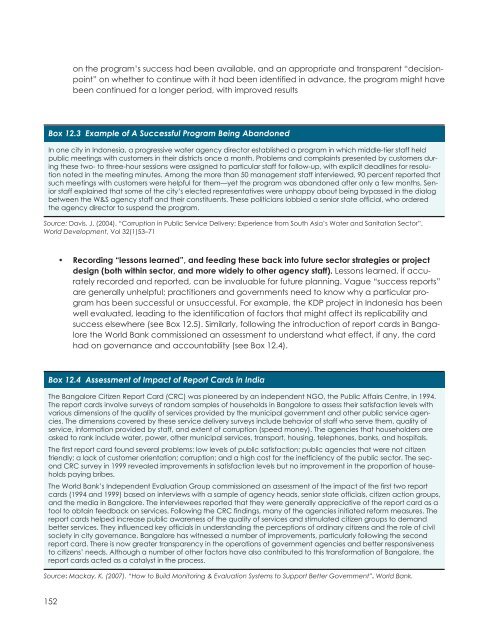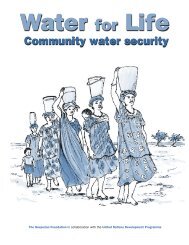A Sourcebook - UN-Water
A Sourcebook - UN-Water
A Sourcebook - UN-Water
You also want an ePaper? Increase the reach of your titles
YUMPU automatically turns print PDFs into web optimized ePapers that Google loves.
on the program’s success had been available, and an appropriate and transparent “decisionpoint”<br />
on whether to continue with it had been identified in advance, the program might have<br />
been continued for a longer period, with improved results<br />
Box 12.3 Example of A Successful Program Being Abandoned<br />
In one city in Indonesia, a progressive water agency director established a program in which middle-tier staff held<br />
public meetings with customers in their districts once a month. Problems and complaints presented by customers during<br />
these two- to three-hour sessions were assigned to particular staff for follow-up, with explicit deadlines for resolution<br />
noted in the meeting minutes. Among the more than 50 management staff interviewed, 90 percent reported that<br />
such meetings with customers were helpful for them—yet the program was abandoned after only a few months. Senior<br />
staff explained that some of the city’s elected representatives were unhappy about being bypassed in the dialog<br />
between the W&S agency staff and their constituents. These politicians lobbied a senior state official, who ordered<br />
the agency director to suspend the program.<br />
Source: Davis, J. (2004). “Corruption in Public Service Delivery: Experience from South Asia’s <strong>Water</strong> and Sanitation Sector”.<br />
World Development, Vol 32(1)53–71<br />
• R ecording “lessons learned”, and feeding these back into future sector strategies or project<br />
design (both within sector, and more widely to other agency staff). Lessons learned, if accurately<br />
recorded and reported, can be invaluable for future planning. Vague “success reports”<br />
are generally unhelpful; practitioners and governments need to know why a particular program<br />
has been successful or unsuccessful. For example, the KDP project in Indonesia has been<br />
well evaluated, leading to the identification of factors that might affect its replicability and<br />
success elsewhere (see Box 12.5). Similarly, following the introduction of report cards in Bangalore<br />
the World Bank commissioned an assessment to understand what effect, if any, the card<br />
had on governance and accountability (see Box 12.4).<br />
Box 12.4 Assessment of Impact of Report Cards in India<br />
The Bangalore Citizen Report Card (CRC) was pioneered by an independent NGO, the Public Affairs Centre, in 1994.<br />
The report cards involve surveys of random samples of households in Bangalore to assess their satisfaction levels with<br />
various dimensions of the quality of services provided by the municipal government and other public service agencies.<br />
The dimensions covered by these service delivery surveys include behavior of staff who serve them, quality of<br />
service, information provided by staff, and extent of corruption (speed money). The agencies that householders are<br />
asked to rank include water, power, other municipal services, transport, housing, telephones, banks, and hospitals.<br />
The first report card found several problems: low levels of public satisfaction; public agencies that were not citizen<br />
friendly; a lack of customer orientation; corruption; and a high cost for the inefficiency of the public sector. The second<br />
CRC survey in 1999 revealed improvements in satisfaction levels but no improvement in the proportion of households<br />
paying bribes.<br />
The World Bank’s Independent Evaluation Group commissioned an assessment of the impact of the first two report<br />
cards (1994 and 1999) based on interviews with a sample of agency heads, senior state officials, citizen action groups,<br />
and the media in Bangalore. The interviewees reported that they were generally appreciative of the report card as a<br />
tool to obtain feedback on services. Following the CRC findings, many of the agencies initiated reform measures. The<br />
report cards helped increase public awareness of the quality of services and stimulated citizen groups to demand<br />
better services. They influenced key officials in understanding the perceptions of ordinary citizens and the role of civil<br />
society in city governance. Bangalore has witnessed a number of improvements, particularly following the second<br />
report card. There is now greater transparency in the operations of government agencies and better responsiveness<br />
to citizens’ needs. Although a number of other factors have also contributed to this transformation of Bangalore, the<br />
report cards acted as a catalyst in the process.<br />
Source: Mackay, K. (2007). “How to Build Monitoring & Evaluation Systems to Support Better Government”. World Bank.<br />
152
















